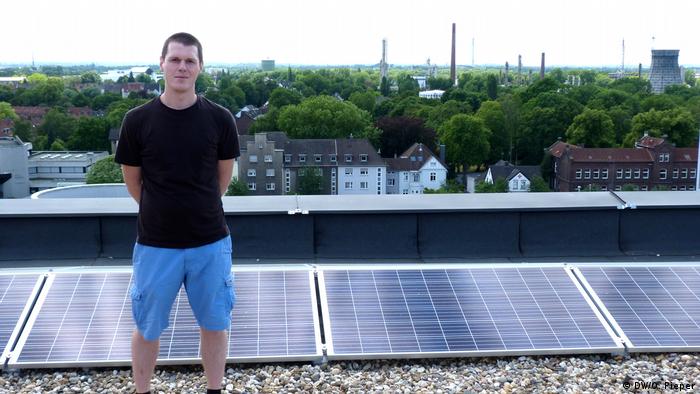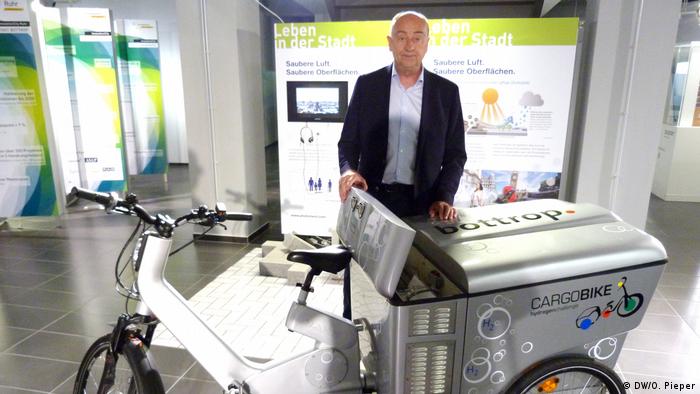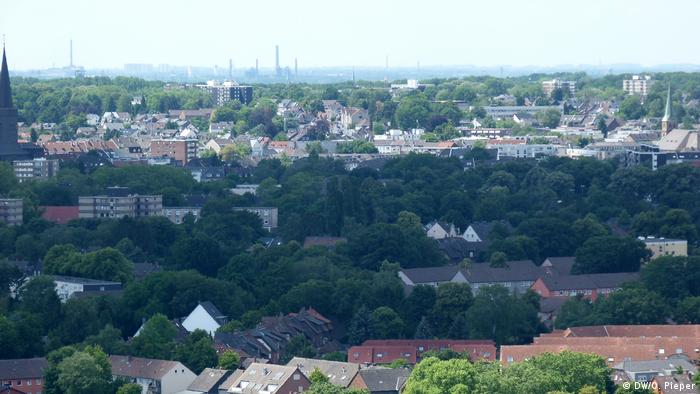All the talk about the phase-out of brown coal, less air travel and the air pollution by the automotive industry. In Germany can reduce, especially with the renovation of buildings of its CO2 emissions massively.

Entrepreneur Steven Engler on the roof of the shopping centre, City centre, in Herne, Germany
The photovoltaic system is sufficient for him on the roof, the year of 33,000 kilograms of CO2 are saved? Plus the five ultra-modern ventilation systems, the cost of each of the 700,000 Euro and Steven Engler only tenderly, “my little Lamborghini calls”? No, the owner of the City Center in Herne, Germany, has thought of something very special: On the roof of the shopping centre in the middle of the Ruhr area in West Germany totals soon to 50,000 bees. “This is also part of sustainability that we will be greening the roof and the bees good honey produce,” says Engler, laughing.
What the 34-year-old real estate businessman from the City Center, is a bit like how to save a dinosaur from extinction and sustainably. In the 1970s, built, belonged to the City Center is the first shopping centres in Germany. But the former glory was little left: shops moved or made dense, it was not renovated or replaced, energy saving, no trace.
Two years ago, about half of the centre empty, a death on the installment plan. Steven Engler came in a roundabout way into the game: “I told my father at that time, let’s just leave it alone. Then I went on vacation. Meanwhile, he has bought it as the head of our company.”
The entrepreneur, who is also a climate scientist
The son went to work. He turned everything on the 17,000 square meters and stayed always out to modernize energy, he said: He replaced the old slate facades against a thermal insulation system, insulated all the Windows. Finally, he took off the entire roof because the old one was leaking, and cleaned up the garage.
He put a small LED-lamps, the address only in case of movement. “It fit quite well, that I have at the University of my own research focus on renewable energies. I could so design and implementation”, explained Engler, who has a PhD on the topic of climate extremes.

To the City Center in Herne, office buildings and apartments next to the shopping centre (rear)
In a few weeks, the City Center should be ready. The Herne can donate ice cream, blood plasma, or in the largest Woolworth market in Germany to shop. Energy storage is the shopping center does not need, it is self-sufficient. “We are now cost nearly 20 million euros in the renovation,” says the entrepreneur: “It will take nine to twelve years, until we have the money back in.”
Of course, Engler would like to earn money. But he also wants to strengthen – as energy conscious as possible – his home-the Ruhr area – he was born a few kilometres further to the West in Gelsenkirchen: “I, as an entrepreneur, a responsibility. And if I have the opportunity to do so, such as here, in Herne, Germany, I need to do that too!”
The energy consultant, who is also the mayor was
The man who has brought many people in the Region to think like Steven Engler, has removed his office to no more than 20 kilometers in Bottrop. Burkhard Drescher is Executive Director of the climate in the project innovation city. Actually, the 68 could enjoy Year long since his retirement, instead he is fighting tirelessly for a climate-friendly city development. With success: Bottrop, with its 117,000 inhabitants has reduced the CO2 emissions in the last ten years by 50 percent.
The buildings generate in Germany, around a third of CO2 emissions. Drescher still want to do more: “We can modernize with relatively simple measures, such as insulation of Windows, Save and cellars in the country energetically. The potential of photovoltaics in the Ruhr area would be sufficient to supply the Region’s independent power, without promoting a single Tonne of brown coal.”

Burkhard Drescher, CEO of innovation city, with a bike, is powered with hydrogen
Burkhard Drescher knows structural change and climate protection. He knows how to moderated these topics, and organized. 20 years ago, he left as mayor of the city of Oberhausen, a former industrial site into a new city centre rebuild. The tram drove, the public transport was promoted, he said. Now he has made Bottrop the climate-model city. An example is the steel company that proudly advertises with a photovoltaic plant and a chemical power storage, under the Slogan “sun and steel welds”. Or the colorful Plus-energy house in the social housing, the generated with geothermal energy, heat pump and ventilation system with heat recovery, more energy, than it consumes.

Climate awareness also works in social housing: the Plus-energy house Bottrop
The climate-model city, which was formerly in coal
Especially Drescher, tens of thousands of citizens in Bottrop from the climate-friendly building refurbishment has been convinced – with small steps, he says. You could dispense with 100 percent CO2 savings through an expensive insulation of the roof and prefer to 90 percent savings with small money to achieve.
“Germany is built,” says Drescher, and calls for a rethink in the promotion: “We have had in Germany last year 300,000 new buildings, but we have 20 million building. It has so far failed to put the balance on incentives for CO2 savings.”

Bottrop won in 2010 in a competition with the aim to develop a city model for energy efficiency
Maybe something is happening now in the energy-related modernization in Germany. The Federal environment Minister, Svenja Schulze, this week in Bottrop. She sees innovation city as a model for other cities in Germany, some are already become noisy: The Berlin Senate wants energy concepts for the capital city, also Hamburg and Osnabrück have come on Board.
Only a Kilometer away from the mine Prosper-Haniel, which made it as the last coal mine in the Ruhr area in 2018, sealing, hopes Burkhard Drescher, therefore, a pulse for the whole of Germany: “The Region with coal and steel, energy Central Europe, could now become a pioneer in climate-neutral cities.”